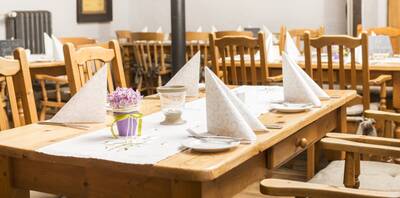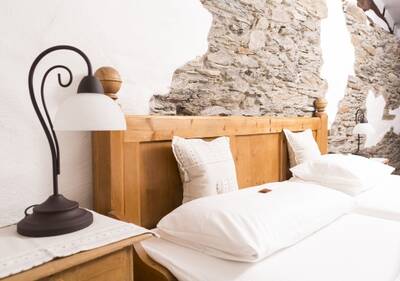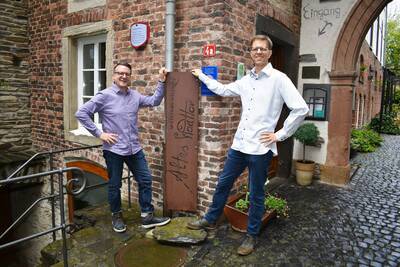You may have wondered why your room does not have a number, but a name. The room names in our house all have a historical reference - either to the house and its former use or to the town of Kastellaun.
History
Erfahren Sie mehr über die Historie der Zimmer bei und im Hotel "Altes Stadttor" in Kastellaun
Wall dwelling
In the Mauerstübchen you sleep in front of a section of Kastellaun's medieval town wall, which has been preserved in this building. It dates back to the 13th century and was built by the Counts of Sponheim in connection with the construction of Kastellaun Castle. It secured the market town of Kastellaun after Emperor Heinrich VI granted Kastellaun market rights in 1309.
In the course of the Palatinate War of Succession - the French Sun King Louis XIV tried to assert his claim to the Electoral Palatinate as an inheritance by military means - French troops destroyed a large number of settlements, castles and palaces in southwestern Germany. With the large-scale destruction of fortified buildings, France wanted to make any future military threat from the empire more difficult. There is an eyewitness account of the planned destruction in April 1689 by the bailiff Georg Friedrich von Wolframsdorf. Here is an excerpt, concerning the front city gate (today hotel "Altes Stadttor") which describes the destruction by mines: ... after the castle was built, several mines were laid in the city, as under the high watchtower on the right hand, when one goes through the gate into the city...
Parts of the city wall were spared, they served the citizens of Kastellaun as quarry or were integrated, as here, in building projects. After the Maull family had used the remaining part of the town wall at the front town gate as the right-hand gable wall of their new residential building in 1799, a large barn with stables was added in 1895, which today houses the hotel "Altes Stadttor".
Guardroom
In the Middle Ages, a guardroom was the name given to a guard's common room, which was often located inside a city gate. Until the early modern era, a city gate was usually a specially reinforced passage through the ring wall of a city. Towers and gates, in addition to the city wall, served to protect the city core from enemies. The city gates were - as in Kastellaun - often secured with a drawbridge that bridged the moat integrated into the wall ring. Additional protection was provided by wooden or iron grates that could be lowered and mighty oak doors.
In the 19th century, representative city gates without military function were erected, but they served, for example, to collect customs or to control the night's rest - so-called "Torsperre" ("just before the gate closes"). These were often designed in a classical and representative style. This gate barrier was successively abolished in individual towns at the end of the 19th century.
Today, many city gates serve as landmarks of a city and attract tourists. Other former locations of gates are important urban squares, without the corresponding gate buildings still existing today. The front Kastellaun town gate at today's hotel and country inn fell victim to destruction by French troops in 1689 in connection with the castle demolition.
Town seal
The term seal can be traced back to the 14th century and is derived from the Middle High German "sigel" and the Middle Low German "se(g)gel". It is a form of authentication of documents or assurance of the integrity of objects or containers (envelope, door) with the help of a seal stamp, a so-called "typar" which is pressed into a soft, hardening mass (sealing wax, wax, earlier also clay).
The earliest stamp seals can be traced back to around 3,000 BC in the Near East. Seals were first used by individuals, later also by corporate bodies. Imperial seals have existed in Byzantium since the 6th century, papal seals since the 9th century. In the early and high Middle Ages, emperors, kings, members of the nobility and the high clergy used seals. Since about the 13th century, citizens also made use of this type of authentication. City seals can be found since the beginning of the 12th century.
A seal stamp with a handle is called a petschaft - its predecessors were signet rings. The seal itself may be pressed onto the document or may have a cut through it in the parchment. Attached seals are attached to strings of hemp, silk, other fabrics, or strips of parchment.
Legally, each official seal is unique. Who may carry it is specifically regulated. The breaking of a seal, the unauthorized destruction of a seal affixed by an authority, an official or otherwise on official business, is punishable in Germany. A seal stamp of an authority which has become unusable may only be destroyed with the involvement of a witness and with an appropriate protocol.
The coat of arms of Kastellaun originates from a court seal from the 15th century.
Granary
In earlier times, a granary was the name given to a separate storage room for grain, where the grains were kept in sacks. Today's hotel "Altes Stadttor" had been built and used as a stable and barn building by the Maull family in 1895. On the spacious floors of the barn also stored the grain of the last harvest as a stock for the often harsh winter.
In the Hunsrück, farming was mainly done for one's own needs. Thus, oats, wheat, barley and rye were planted for fodder purposes and for further use by humans, as well as clover, alfalfa and the like for the cattle. The hard soil was worked with plow, harrow, cultivator, heap and roller. The implements were mainly pulled by cows and oxen; richer farmers, among whom was the Maull family in Kastellaun, also used horses for this work. While initially sowing was done by hand, later the sowing machine made the work easier.
The grain was cut with the Räff on the field, piled up to sheaves and after drying on a ladder wagon, which was pulled by the cattle transported home. On the farm the grains were then extracted first with the flail and later with the threshing machine. The resulting chaff was used in the past, among other things, as stuffing for pillows and bedding. In Mörsdorf, very close to Kastellaun, people called the chaff "Koof" and were happy when after the harvest traditionally the filling was exchanged with bed. Later, the saying arose: "En der Koof hat man goot geschloof" (In the chaff bed one slept well).
Bower
The early "burgenkundliche" literature of the 19th century saw in the bower a living and working room in a castle that could be heated by means of a fireplace or tiled stove and was usually reserved for women, knights and nobles (Latin caminus = stove, fireplace, fireplace, caminata = heated living space).
Also in noble courts and later in wealthy bourgeois houses, bower rooms were heatable rooms or halls built of stone, or independent, often tower-like buildings (residential towers).
Also in the castle Kastellaun will have had a Kemenate, which could donate the inhabitants in the winter some warmth since the large part of the castle rooms were not heatable or could be heated due to the structural conditions only scantily.
The bower in the "Old City Gate" is heated by a central heating system and, due to its size, is a cozy room for one or two guests.
Hay barn
The building, which today houses the country inn "Altes Stadttor", is a former barn and stable building from 1895 and used to belong to the Maull family's residential house located to the left of it. On the first floor there were stables for horses, cows and pigs. On the upper floor there was the threshing floor, i.e. the storage rooms for grain and hay - the latter is also called hay barn in Hunsrück.
Hay is the dried above-ground biomass of grassland plants. It is usually used as fodder for livestock and domestic animals. Coumarin gives fresh hay its peculiar, pleasantly spicy odor. In order to preserve the growth of grasses and, as a rule, meadow herbs by dehydration, the mown growth must be dried as quickly as possible, but at the same time gently, to a dry matter content of over 80%. In Hunsrück, soil drying, which was common in the past as well as today, involves leaving the growth on the grassland for several days after mowing for the purpose of air drying. Mowing was once done by hand using a scythe. In order to speed up the drying process, the hay was then spread out and turned several times in the following days with a pitchfork (in the Hunsrück region they say "mir gieh Hei wenne"). When the weather was good and the drying was completed, the hay was raked and transported to the farm with the pitchfork on a cart pulled by horses, oxen or cows. If not sufficiently dried, there is a risk of spontaneous combustion during subsequent storage in the hayloft (or hay barn).
Guilder Chamber
From its origin, the guilder denotes a gold coin. In the course of time, the term florin also stood for a unit of account and a silver coin. A distinction is therefore made between gold florins, invoice florins and silver florins. In the Holy Roman Empire of the German Nation (Middle Ages to 1806), the name florin became established early on when King John of Bohemia had gold florins struck in Prague in 1325, thus introducing his own gold coinage.
The Rhenish gold florin came into being when the Elector Archbishops of Cologne, Trier and Mainz pledged their support for the election of Charles IV. (1346 - 1378) as German king with the gold coin privilege. In the Golden Bull of 1356 this right was extended to all electors.
Subsequently, the history of the gold guilders in the west of the empire is characterized by the fact that the mint lords and tenants constantly succumbed to the temptation to secretly lower the gold content. Especially the trade concentrated in the cities constantly complained about the substandard guilders. The emperors, in turn, tried to at least contain the lowering of the coinage, if they could not prevent it. Theoretically, this was done on the basis of Imperial Diet resolutions and coinage treaties. Thus, the fineness of gold was to be exactly 19 carats from 1420 to 1490. In the course of time, the worst German guilders only brought it to 15 carats, and the worst Dutch ones even only to 8 carats. Despite this unreliability, the Rhenish florin was the main coin in the Holy Roman Empire until the beginning of the modern era, when it was replaced by the thaler.
The Canton of Kastellaun had to pay a total of 7327 florins in war tribute to the French in 1794 - 1976.
Because of their value, guilders were kept in a well locked room, usually with other valuables such as jewelry or the like - these rooms were called guilder chambers or treasuries.
Shepherd's Chamber
The meaning of the room name "shepherd's room" does not immediately come to mind, because here two words that actually do not belong together have been combined, namely the "shepherd" and the "room". The "shepherd" is known to us as the keeper of a herd of farm animals such as sheep, goats, in the past also geese, pigs, cattle and horses. The traditional working environment of the shepherd is characterized by his closeness to his livestock, because the shepherd sometimes stays in the pasture at night and protects his flock. Especially in earlier times, shepherds stay continuously with their herds to lead them to another place after grazing the grass. The wandering shepherd usually existed in places where the pasture land was not very fertile and the livestock of the individual farmers was small. He took over the cattle for care mainly during the summer half-year. Therefore, shepherds often did not have a permanent residence and a shepherd cart served as a place to live and sleep. The shepherd crawled legs first into the cart onto the meager straw bedding, which was common in the beginning. If he was lucky, a farmer brought a hot roof tile to warm him in winter. From the end of the 19th century shepherd carts were built in which one could stand. The two-wheeled wooden carts, closed all around, usually contained a couch, a small table top and a bench, and were used by the shepherd as a weather shelter, sleeping and storage depot, and a writing place.
A "Gemach" (from Middle High German) refers to a comfortable, stylish chamber, parlor, or living space in a castle or palace. In your room "Hirtengemach" combines the form and material (wood) of a shepherd's hutch and the coziness of a room that certainly would have liked a shepherd in earlier times.
Citizen's Room
The citizens' room is dedicated to the citizens of the medieval town of Kastellaun. In the sense of the order of estates, they were the inhabitants of a fortified city that sheltered and protected them, with their own estates (Latin statús). The system of estates was considered by the people of the Middle Ages and early modern times as a fixed, God-given order, in which everyone had his unchanged place. One was born into one's estate and, as a rule, advancement was not possible. The first estate included the group of all clergy, i.e. members of the high clergy as well as the lower clergy. The second estate included the nobility. Here, too, it did not matter whether one came from a higher noble class or from a lower one and belonged, for example, to the impoverished landed gentry. The third estate included all free peasants and citizens. At the top of the pyramid of estates were the princes and the king or emperor or, in the case of the clergy, the bishops and the pope.
In the medieval constitution of a town, a burgher was a full member of the community, enjoying all rights and duties. The other inhabitants of the place were called inhabitants or bystanders. These terms applied only to men, women could never be bearers of such a title according to the legal conception of that time. The burgher class emerged with the formation of the town. The citizens did not owe taxes and duties to a landlord like the peasants, but to the city, which in turn had to pay its duties to the king. The city provided protection and the citizen had to perform military service or provide war servants in case of defense. Within the bourgeoisie there were also great differences in social status depending on various factors such as profession, marital status, rights in the municipality or membership in guilds and guilds.
Broom closet
Almost every house and many apartments in the world have a small room in which the cleaning items are stored. In the past, in addition to sand, soap and soda, there were only brooms, mops, scrubbers and cleaning buckets, but today you can also find modern damp mopping equipment together with your floor-specific cleaning agent, vacuum cleaners or, as the latest achievement of technology, a vacuum robot that does the cleaning work all by itself. For such a storage room the name broom closet has prevailed. In the house "Maull", which is adjacent to the "Old City Gate", there was already a broom closet in 1799, in which the diligent housewives stored their cleaning utensils.
In popular belief, the broom, the eponym and fixed component of a broom closet, is also the preferred means of transport of witches, who ride on it through the air. In the time of the witch hunt one was to the persons accused of the witchcraft before that you on animals, in addition, on furnace forks, sticks or brooms to their meetings with the devil flew. You would have left the house through the door, a window or the chimney. In the Hunsrück, too, people called witches were persecuted - for Kastellaun, witch hunts and even witch burnings are historically documented.
The term "broom closet" was on everyone's lips in 1999 after Boris Becker had a stone jump with the model Angela Erwakowa in the broom closet of a hotel, resulting in his illegitimate daughter Anna. His wife Barbara then divorced him.
The broom found its way into quotations and sayings and everyone knows the saying: "New brooms sweep well" or "Sweep in front of your own door".





